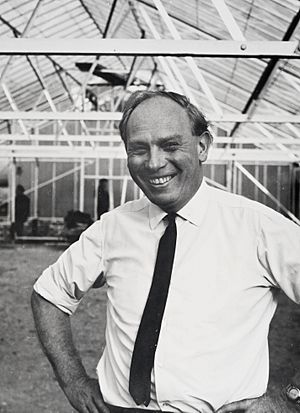Roy Markham facts for kids
Quick facts for kids
Roy Markham
|
|
|---|---|

Roy Markham at the glasshouses of the John Innes Institute in 1967.
|
|
| Born | 29 January 1916 London, United Kingdom
|
| Died | 16 November 1979 (aged 63) |
| Office | Director of the John Innes Institute |
| Term | 1967–1979 |
| Predecessor | Kenneth S Dodds |
| Successor | Harold Woolhouse |
| Spouse(s) | Margaret Mullen |
| Alma mater | University of Cambridge |
| Scientific career | |
| Fields | |
| Institutions |
|
| Doctoral advisor | Norman Pirie |
| Signature | |
 |
|
Roy Markham (born January 29, 1916 – died November 16, 1979) was a British scientist. He studied plant viruses. He was also the fifth director of the John Innes Centre from 1967 until he passed away in 1979. He was a Fellow of the Royal Society, which is a big honor for scientists.
Contents
Early Life and School
Roy Markham was born in London in 1916. When he was young, his family moved to Bridge of Allan in Scotland. They moved back to London in 1925.
Roy went to several schools in England and even in Magdeburg, Germany. He didn't like these schools much. But when he was 15, he started at St Paul's School in London and enjoyed it.
During his summer breaks, Roy loved visiting his family's house in Ventnor on the Isle of Wight. It was there that he met Margaret Mullen. She later became his wife.
What Did Roy Markham Study?
In 1935, Roy Markham started studying at Christ's College, Cambridge. He chose to focus on biochemistry, which is the study of the chemistry of living things. He finished his degree in 1938.
After college, he became a PhD student. He worked in the lab of Norman Pirie, who was his teacher. For his PhD, which he finished in 1944, Roy studied how to find and separate plant viruses. These included the tomato bushy stunt virus and the tobacco mosaic virus (TMV).
Research on Viruses
After getting his PhD, Roy Markham kept working in Cambridge. He joined the Molteno Institute. There, he studied the biochemistry of RNAs. RNA is like a blueprint for living things, similar to DNA.
One of his colleagues in Cambridge was James Watson. Watson later became famous for discovering the structure of DNA. In his book, The Double Helix, Watson wrote about asking Roy Markham for some TMV for an experiment:
I thus went to Roy Markham to see if any spare TMV was on hand. Markham then worked in the Molteno Institute, which unlike all other Cambridge labs, was well heated. This unusual state came from the asthma of David Keilin, then the Quick Professor and Director of the Molteno. I always welcomed an excuse to exist momentarily at 70 °F (21 °C) even though I was never sure when Markham would start the conversation by saying how bad I looked, implying that if I had been brought up on English beer I would not be in my sorry state. This time he was unexpectedly sympathetic and without hesitation volunteered some virus. The idea of Francis and me dirtying our hands with experiments brought unconcealed amusement.
In the late 1950s, Roy went back to studying the structure of plant viruses. He was very interested in using electron microscopy. This is a special way to use powerful microscopes to see tiny details of viruses.
Leading Virus Research
In 1960, Roy Markham became the director of the Agricultural Research Council (ARC) Virus Research Unit in Cambridge. He took over from Kenneth Smith. This research station had first opened in 1927.
Moving the John Innes Institute
The John Innes Institute was a famous research center. In 1967, it moved from Bayfordbury to Norwich, Norfolk. This move happened because the institute was joining with the new University of East Anglia (UEA).
Before the move was finished, the institute's director, Kenneth S Dodds, left his job. He went to work for the Food and Agriculture Organization in Turkey. Roy Markham was chosen to be the new director. He and his Virus Research Unit moved to Norwich in October 1967.
Roy Markham was very important in setting up the institute in its new home. Many staff members had left during the move. Only 17 people moved to Norwich in 1967. But under Roy's leadership, the institute grew. It was reorganized into four new departments: Cell Biology, Genetics, Applied Genetics, and Ultrastructural Studies.
Roy also convinced the people who managed the John Innes Foundation to build a large lecture hall and fun places for staff, like a swimming pool. He was very interested in new technology at the institute. He even listed himself under the 'Electronics Section' in the institute's yearly reports.
Later Life and Passing
In 1978, Roy Markham had a heart attack, but he got better. Sadly, he later got bowel cancer and passed away on November 16, 1979.

